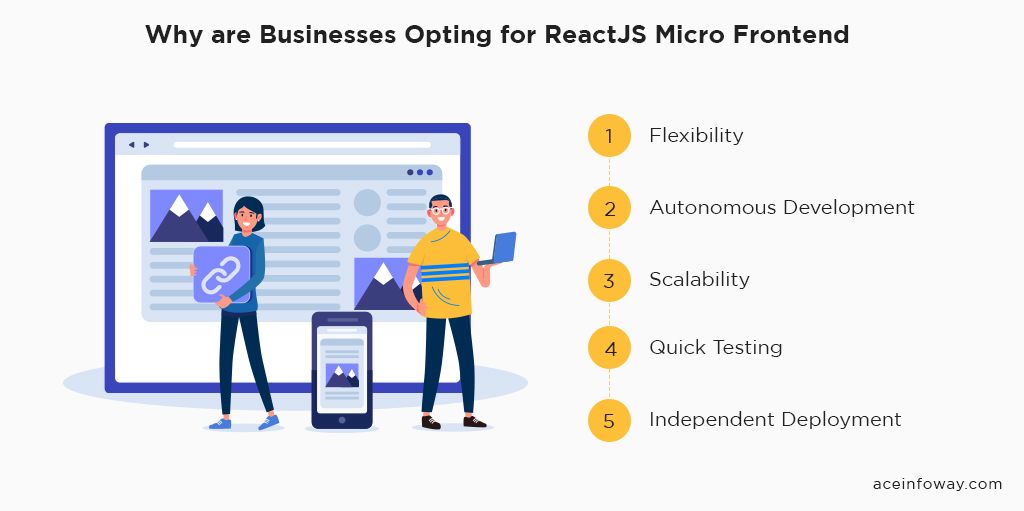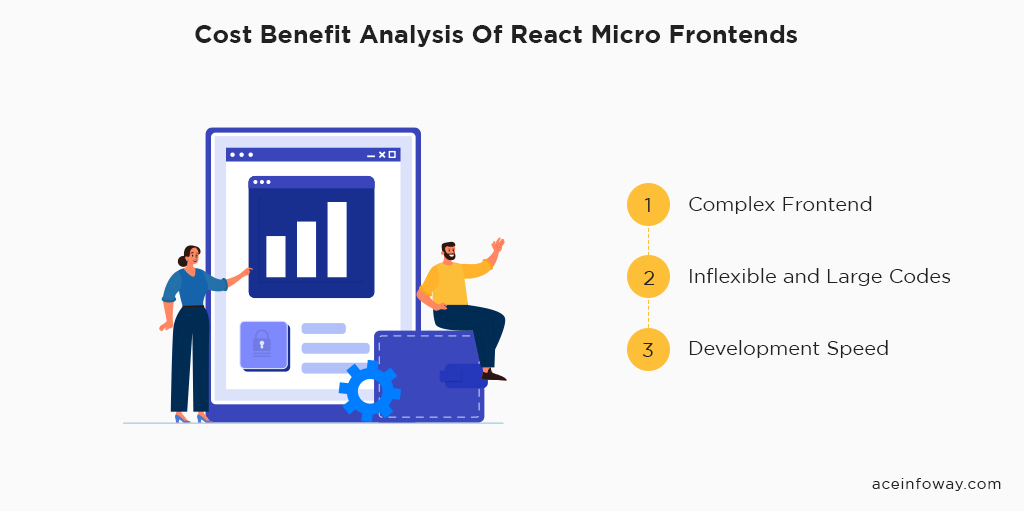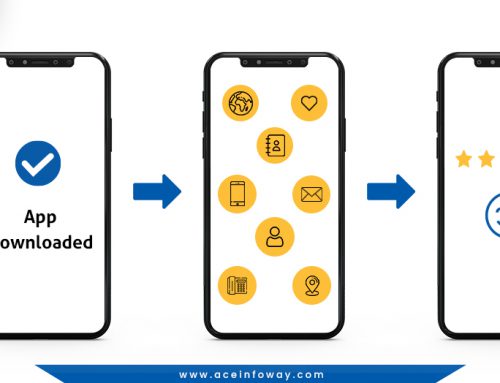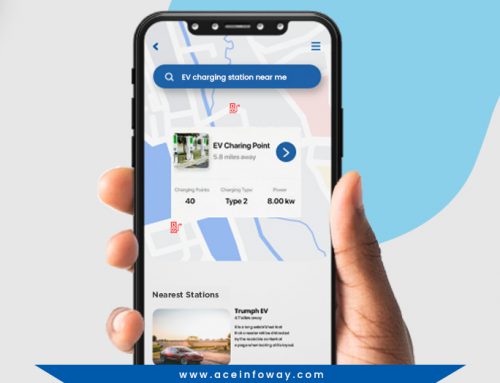Table of Contents
For any business, app abandonment or poor user interface is more than a nightmare. Are you worried that prolonged loading time or unappealing UI would make users abandon your website or app?
Ace Infoway has helped several businesses with software and app development by creating engaging user interfaces (UI), improving user experience, and optimizing overall app performance. And it majorly depends upon the frameworks and libraries you choose to build your business app.
As per the survey conducted by Statista in 2022, 42.62% of developers adhere to the ReactJS micro frontend as it gives humongous advantages to the developer, business owners, and end users.

Software Development: Best Practices of Build Your Own Team (BYOT)
Get your free copy
What is Micro Frontend?
Developers and businesses have bid adieu to monolithic architecture- used widely for decades. Micro frontend development is a new norm that eases the development process and gives an appealing user interface to the target audience.
Using ReactJS for building micro frontend makes it possible to split the frontend monoliths into several, smaller, and more manageable components.
With react micro frontend, multiple teams can build components using different technologies making the development process easy, quick, and variant. This helps businesses to continue their operation without any impediment.
Why are Businesses Opting for ReactJS Micro Frontend?

Multiple businesses of all scales are embracing react micro frontend owing to its enormous technological advancement giving the best user interface experience to the target audience.
From medium-scale to enterprise-level businesses have multi-layer websites or applications with several features, services, and tools. With high online traffic, it becomes crucial for organizations to have quick responsive apps or websites, maintain data security, and robust apps for powerful performance.
Businesses keep on updating their website or app to provide a better user experience. The updates may include the addition and elimination of certain tools and interfaces.
Having ReactJS micro frontends simplifies the customization of the app without hindering other interfaces of the app. We have worked with several businesses and provided them with appealing UI using react micro frontend without any obstruction to parallel interfaces and the online operation of the clients.
Here are some of the reasons why businesses prefer ReactJS micro frontend for building their apps:
💡Flexibility
Business and app-related technologies tend to change over time and will need timely upgradation that too in an unanticipated way. To cope with the current market trends and evolving user behavior enterprises need to make certain changes in technologies.
Having a react micro frontend makes customization easy and rapid without interrupting the overall performance and interfaces of the frontend. Because components of the interfaces are divided into smaller components simplifying the adaption of new technologies with a smaller codebase.
💡Autonomous Development
The monolithic architecture of the traditional frontend often limits the businesses as well as developers when it comes to individual ownership. Because a monolithic frontend can’t be engineered or customized without impacting the rest of the codebase.
Instead, micro frontend react allows businesses to get freed from multi-layer approvals and tedious development processes. These micro-services of the frontend offer full ownership to make the changes and updates keeping the routine online business operation ongoing.
💡Scalability
As multiple teams with developers can work in parallel with react micro frontends it becomes easy for businesses to add new features, and interfaces in no time.
With small codebases, it becomes easy to integrate the new capabilities hassle-free and without impacting the performance of other features and interfaces of the frontend.
Also, it is possible to combine different frameworks or libraries in a single project giving liberty to the businesses to stack multiple technologies and get a desirable result and user experience.
💡Quick Testing
In the monolithic frontend, testing could be an arduous job as testing takes place across the entire application. Testing is an unavoidable process- as it helps in controlling the problems that could be encountered during business operations.
In monolithic architecture, though changes are simple and frivolous the entire codebase needs to be testified which consumes a considerable amount of time. Such an extensive testing process may delay the deployment and launch of the app which result in missing the market opportunity.
To avoid such situations, micro frontend react simplifies the testing process by self-containing the single micro-app. Even if a bug or issue erupts during testing it stays limited to the micro frontend component- not affecting other components of the frontend.
💡Independent Deployment
React’s micro frontend architecture allows the deployment of different components individually. It doesn’t matter where the code resides or is hosted, each micro frontend component possesses a development pipeline that includes building, testing, and deployment.
As you can deploy the react micro frontends individually it also allows you to ship features in lesser time. Unlike a monolithic frontend, micro-services don’t obstruct you from deploying a ready part.
Cost Benefit Analysis Of React Micro Frontends
 A cost-benefit analysis is indeed necessary to identify and quantify the benefits related to the micro frontends. We are listing some cost drivers that monolithic architecture imposes on businesses. It may vary depending on the nature of the business and other factors but top cost drivers are listed below.
A cost-benefit analysis is indeed necessary to identify and quantify the benefits related to the micro frontends. We are listing some cost drivers that monolithic architecture imposes on businesses. It may vary depending on the nature of the business and other factors but top cost drivers are listed below.
💡Complex Frontend
Complex and large frontend invites increased maintenance costs. Businesses may have to incur extra expenses due to the inflexibility and scaling difficulties of the traditional monolithic frontend. The complex monolithic frontend can also obstruct the revenue-generating activities of the app which in turn may require extra costs for the solutions.
💡Inflexible and Large Codes
Dependence on one single codebase in monolithic architecture distresses businesses as well as developers. This dependency on a single codebase requires extra development, testing, integration, and deployment time.
ReactJS micro frontend depends on multiple components with a small codebase making it more agile and efficient. Such micro frontends with smaller codes are easy to scale, require no-to-less maintenance, and reduce barriers to business operations.
💡Development Speed
Undoubtedly, the monolithic frontend requires more development time, intensive updates, resources, and integration- all these factors affect the development speed, making it more time-consuming.
While in react micro frontend codes are smaller as well as simple. The micro-services are independent of each other with multiple developers and teams working individually on each component. This helps in accelerating the speed of project delivery.
The cost of updating frontend monoliths is unpredictable and it can be banished with this streamlined and modular approach of react micro frontend architecture.
Conclusion
Micro-frontend react is ideal not just for enterprises but it is equally beneficial for SMEs and startups. Micro frontend architecture developed with react simplifies the development, integration, testing, and deployment process by dividing entire complex projects into smaller components. It allows multiple teams and developers to work individually with multiple technology stacks, frameworks, and libraries. Feel free to contact us, if you want to get react micro frontend development accomplished by an experienced team.

























